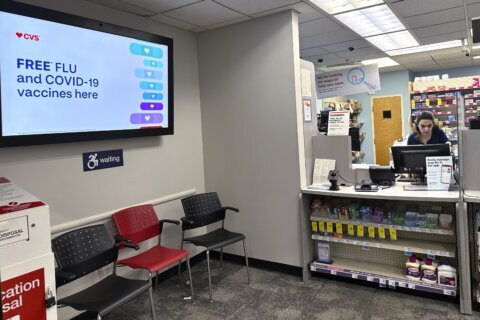Pack less
The living situation in college dorms is often far from glamorous. Space is limited and students are typically living with at least one other person. Some students overpack, while others don’t pack enough. It’s best to be in the latter camp at first, and bring more stuff later after assessing the space, says Wesley Rodgers, associate director of residence life at Pepperdine University in California. It’s also wise if roommates coordinate on what to bring so there are no unnecessary duplicates. One rule of thumb is for students to bring half of what they think they will need, Amy Badal, dean of students at Bucknell University in Pennsylvania, wrote in an email.
In other words, pack only the essentials. Here are some tips from experts and a student on what and how to pack.
Air purifier
Whether students keep their dorm room clean or not, there’s a chance dust, viruses and mold spores can accumulate on surfaces. An air purifier can help filter those out, as well as other allergens, says Fares Marzouk, a rising junior at Pomona College in California. “I think that can be really helpful,” he says. “It can make your room feel cleaner and more homey. If you have any allergies or you’re just a clean freak, I think an air purifier is really helpful.”
Bathrobe
Marzouk says his dorm at Pomona is co-ed. For students in a similar setting, instead of just wearing a towel, he recommends bringing a bathrobe for trips to and from the shower. “It was just really good for me and my peers to have a bathrobe for modesty reasons,” he says. “That was really helpful for me.”
Cleaning supplies
Most roommate conflicts that Rodgers says he’s encountered stemmed from disagreements on cleanliness. Maintaining a clean living space can go a long way for overall health and for keeping the peace with roommates, he says. Some schools may provide cleaning supplies for the dorm community, and the custodial staff will typically clean the floor, but not always individual rooms. Students should bring basic cleaning supplies, Rodgers says. A small vacuum may also be useful, Badal says.
Climate-appropriate clothes
Consider where you’re attending school and let that inform the type of clothes you bring, Rodgers says. Students attending school in a colder climate may want to pack a winter coat and some sweaters, while students in southern California, such as at Pepperdine, should pack swimsuits and leave overcoats behind.
Command strips or other adhesive tools
Students are encouraged to decorate their dorm room or add hooks for towels or other items. When adhering anything to the walls, Rodgers says, students should follow the school’s policy on what can and cannot be attached or drilled into. “Go buy command strips, sticky tack and things that will go onto the wall without damaging it in any sort of way, because that’s going to save you time and money at the end of the year when you have to move out,” he says.
Cookware, dishware and flatware
Community kitchens in residence halls may have some flatware, dishes and cookware, but there’s no way of knowing when or how often items get cleaned, Rodgers says. It’s best for students to bring their own pots and pans, dishes and flatware to use when eating.
Electric kettle
College dorm living is all about efficiency and maximizing the space that’s available. Bringing items that can serve multiple purposes can help students do that. One such item is an electric water kettle, Rodgers says, noting it’s not just for making tea or coffee. It can be used to cook ramen noodles or other food that requires hot water, and to heat water for cleaning purposes.
Eye mask and ear plugs
It’s likely that two roommates have different sleep schedules and habits. One might be ready to go to sleep by 10 p.m., while the other stays up playing video games. In situations like this, an eye mask and ear plugs can help shut out light and drown out noise from a roommate or others in nearby rooms.
Fan
Many residence halls are equipped with air conditioning, but schools in certain regions might not have it in dorm rooms. For students there, a small fan can be useful. Regardless of the climate where students attend school, experts say it’s best to bring a fan on move-in day just in case, as it can also help drown out noise for sleeping.
Label maker
Because students share dorm rooms and there is often foot traffic in and out of the room, there’s a chance items could be taken on purpose or mistakenly. To help avoid this, Rodgers suggests students bring a label maker to identify all of their belongings. “That can help you avoid a lot of conflict down the line if you have that labeled,” he says.
Laundry bag or basket
Dirty clothes and clutter can quickly accumulate in a dorm room. A laundry basket is vital to avoid clothes staying on potentially dirty floors or other surfaces, Badal says. Some students prefer a hamper, which can close and help keep soiled clothes contained and odors to a minimum.
Mattress topper
College dorm mattresses vary in comfort, so students wanting a little extra padding may benefit from a mattress topper — a two- to four-inch layer of memory foam, latex or other material added on top of the mattress for a softer feel. “I think it’s worth it to invest money into a good quality mattress topper because you’re going to be sleeping on it every night,” Marzouk says.
Mini refrigerator
While residence halls may have a community room or a common area that has a refrigerator, space is likely limited if others in the building are using it. Students should prepare to bring their own mini refrigerator so they can maximize space for their food and drinks, Badal notes. You may get a good deal using your student discount.
Noise-canceling headphones
Residence halls can get loud. Similar to ear plugs, noise-canceling headphones can help with focus or sleep. Some students also enjoy listening to music while they study or hang out, so Marzouk says he recommends bringing some to avoid disrupting others as well.
Pictures and souvenirs from home
Whether students are traveling far to attend college or staying close to home, adjusting to life in the dorm may be difficult. To help students feel more comfortable, Badal suggests bringing photos or other souvenirs from home. Decorations such as art, throw pillows and personal photos of family and friends can create an atmosphere that shows your individuality and helps your new peers learn more about you, she says.
Reusable water bottle
Leave the cases of plastic water bottles at home, Badal says. Instead, bring a reusable water bottle. “Every school has water and that’s the last thing you want to be hauling up three flights of stairs,” she says. Using a reusable water bottle can help students save money and limit waste. Marzouk notes that water bottles can also serve as a form of self-expression, as many students like to decorate theirs with stickers.
Shower shoes or flip-flops
Students living in dorm rooms typically share a community bathroom with those on their floor. Bathroom floors, particularly showers, and other surfaces can be hotbeds for bacteria and parasites. Rodgers and others recommend bringing flip-flops or other shoes that can be worn in the shower. “Community bathrooms can get a little gnarly at times,” he says, noting the bathrooms are used 24 hours a day, seven days a week for nine months of the year.
Storage bins and bed risers
Storage in dorm rooms is limited, often to a small closet and a few drawers. If students have more than what will fit, they must find creative solutions. Beds in residence halls often sit high above the floor, which leaves some space for storage underneath. Those looking for extra storage would benefit from a plastic or rubber bin that fits under the bed. If the bed doesn’t sit high enough off the floor, Badal suggests bringing bed risers to help create room for such storage.
Water filter
Students should consider investing in a water filter. In addition to providing clean water, it typically comes with a pitcher to store the water, Marzouk says. Instead of having to make trips down the hall or to the lobby to fill up a cup or water bottle, a water filter and its attached pitcher allow students to keep water on hand in their dorm room.
What not to bring
Many schools, like Pepperdine and Bucknell, include a list of recommended items for dorm living. Those lists also typically include prohibited items. At both Pepperdine and Bucknell, students are prohibited from bringing candles, electric and space heaters, and cooking appliances like toasters and rice cookers. Pepperdine prohibits slow cookers and pressure cookers as well. WiFi cameras, such as those people have outside of their houses, are also prohibited at Pepperdine, and certain types of extension cords may also be prohibited in some dorms.
Essentials for your dorm room
— Air purifier
— Bathrobe
— Cleaning supplies
— Climate-appropriate clothes
— Command strips or other adhesive tools
— Cookware, dishware and flatware
— Electric kettle
— Eye mask and ear plugs
— Fan
— Label maker
— Laundry bag or basket
— Mattress topper
— Mini refrigerator
— Noise-canceling headphones
— Pictures and souvenirs from home
— Reusable water bottle
— Shower shoes or flip-flops
— Storage bins and bed risers
— Water filter
More from U.S. News
How to Find Free College Textbooks
Choosing a Major in College: What to Know
18 Ways to Prepare for Your Freshman Year of College
19 Essentials For Your College Dorm Room originally appeared on usnews.com









